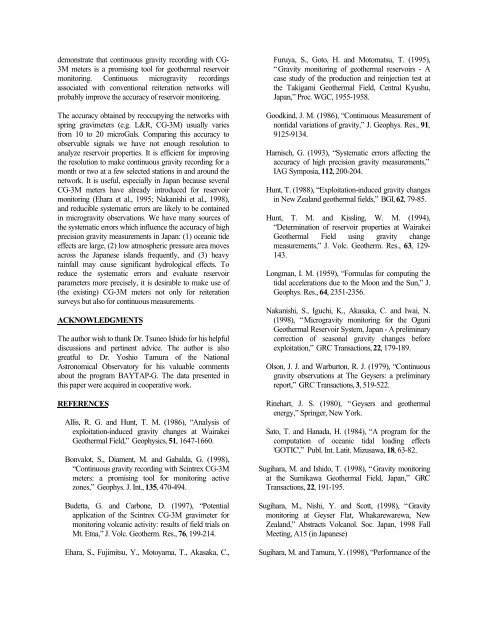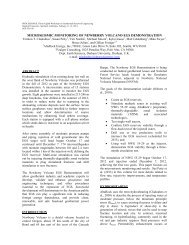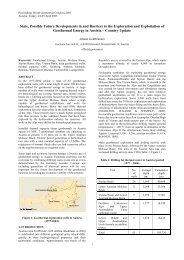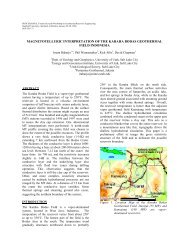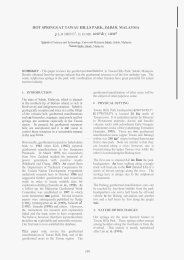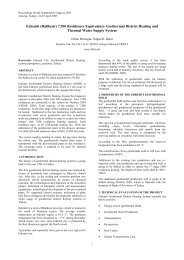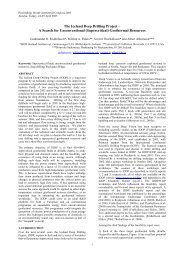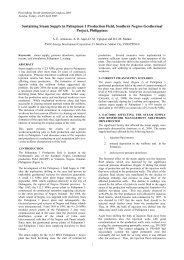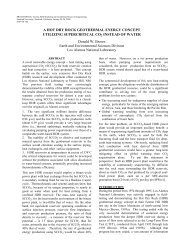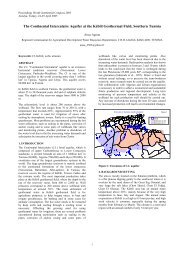CONTINUOUS GRAVITY MEASUREMENTS FOR RESERVOIR ...
CONTINUOUS GRAVITY MEASUREMENTS FOR RESERVOIR ...
CONTINUOUS GRAVITY MEASUREMENTS FOR RESERVOIR ...
You also want an ePaper? Increase the reach of your titles
YUMPU automatically turns print PDFs into web optimized ePapers that Google loves.
demonstrate that continuous gravity recording with CG-<br />
3M meters is a promising tool for geothermal reservoir<br />
monitoring. Continuous microgravity recordings<br />
associated with conventional reiteration networks will<br />
probably improve the accuracy of reservoir monitoring.<br />
The accuracy obtained by reoccupying the networks with<br />
spring gravimeters (e.g. L&R, CG-3M) usually varies<br />
from 10 to 20 microGals. Comparing this accuracy to<br />
observable signals we have not enough resolution to<br />
analyze reservoir properties. It is efficient for improving<br />
the resolution to make continuous gravity recording for a<br />
month or two at a few selected stations in and around the<br />
network. It is useful, especially in Japan because several<br />
CG-3M meters have already introduced for reservoir<br />
monitoring (Ehara et al., 1995; Nakanishi et al., 1998),<br />
and reducible systematic errors are likely to be contained<br />
in microgravity observations. We have many sources of<br />
the systematic errors which influence the accuracy of high<br />
precision gravity measurements in Japan: (1) oceanic tide<br />
effects are large, (2) low atmospheric pressure area moves<br />
across the Japanese islands frequently, and (3) heavy<br />
rainfall may cause significant hydrological effects. To<br />
reduce the systematic errors and evaluate reservoir<br />
parameters more precisely, it is desirable to make use of<br />
(the existing) CG-3M meters not only for reiteration<br />
surveys but also for continuous measurements.<br />
ACKNOWLEDGMENTS<br />
The author wish to thank Dr. Tsuneo Ishido for his helpful<br />
discussions and pertinent advice. The author is also<br />
greatful to Dr. Yoshio Tamura of the National<br />
Astronomical Observatory for his valuable comments<br />
about the program BAYTAP-G. The data presented in<br />
this paper were acquired in cooperative work.<br />
REFERENCES<br />
Allis, R. G. and Hunt, T. M. (1986), “Analysis of<br />
exploitation-induced gravity changes at Wairakei<br />
Geothermal Field,” Geophysics, 51, 1647-1660.<br />
Bonvalot, S., Diament, M. and Gabalda, G. (1998),<br />
“Continuous gravity recording with Scintrex CG-3M<br />
meters: a promising tool for monitoring active<br />
zones,” Geophys. J. Int., 135, 470-494.<br />
Budetta, G. and Carbone, D. (1997), “Potential<br />
application of the Scintrex CG-3M gravimeter for<br />
monitoring volcanic activity: results of field trials on<br />
Mt. Etna,” J. Volc. Geotherm. Res., 76, 199-214.<br />
Ehara, S., Fujimitsu, Y., Motoyama, T., Akasaka, C.,<br />
Furuya, S., Goto, H. and Motomatsu, T. (1995),<br />
“Gravity monitoring of geothermal reservoirs - A<br />
case study of the production and reinjection test at<br />
the Takigami Geothermal Field, Central Kyushu,<br />
Japan,” Proc. WGC, 1955-1958.<br />
Goodkind, J. M. (1986), “Continuous Measurement of<br />
nontidal variations of gravity,” J. Geophys. Res., 91,<br />
9125-9134.<br />
Harnisch, G. (1993), “Systematic errors affecting the<br />
accuracy of high precision gravity measurements,”<br />
IAG Symposia, 112, 200-204.<br />
Hunt, T. (1988), “Exploitation-induced gravity changes<br />
in New Zealand geothermal fields,” BGI, 62, 79-85.<br />
Hunt, T. M. and Kissling, W. M. (1994),<br />
“Determination of reservoir properties at Wairakei<br />
Geothermal Field using gravity change<br />
measurements,” J. Volc. Geotherm. Res., 63, 129-<br />
143.<br />
Longman, I. M. (1959), “Formulas for computing the<br />
tidal accelerations due to the Moon and the Sun,” J.<br />
Geophys. Res., 64, 2351-2356.<br />
Nakanishi, S., Iguchi, K., Akasaka, C. and Iwai, N.<br />
(1998), “Microgravity monitoring for the Oguni<br />
Geothermal Reservoir System, Japan - A preliminary<br />
correction of seasonal gravity changes before<br />
exploitation,” GRC Transactions, 22, 179-189.<br />
Olson, J. J. and Warburton, R. J. (1979), “Continuous<br />
gravity observations at The Geysers: a preliminary<br />
report,” GRC Transactions, 3, 519-522.<br />
Rinehart, J. S. (1980), “Geysers and geothermal<br />
energy,” Springer, New York.<br />
Sato, T. and Hanada, H. (1984), “A program for the<br />
computation of oceanic tidal loading effects<br />
'GOTIC',” Publ. Int. Latit. Mizusawa, 18, 63-82.<br />
Sugihara, M. and Ishido, T. (1998), “Gravity monitoring<br />
at the Sumikawa Geothermal Field, Japan,” GRC<br />
Transactions, 22, 191-195.<br />
Sugihara, M., Nishi, Y. and Scott, (1998), “Gravity<br />
monitoring at Geyser Flat, Whakarewarewa, New<br />
Zealand,” Abstracts Volcanol. Soc. Japan, 1998 Fall<br />
Meeting, A15 (in Japanese)<br />
Sugihara, M. and Tamura, Y. (1998), “Performance of the


